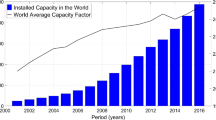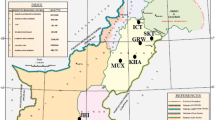Abstract
In order to predict the wind speed at the hub, this paper established the physical model of the wind speed, wind profile method and analytic method based on potential flow theory, the wind tower wind speed extrapolated each fan at hub height wind speed. In order to get the accurate wind power relationship, each fan speed data obtained by extrapolation of wind power output and the corresponding data, the measured power curve model of wind turbine generator by using the maximum likelihood method, the model for the launch of fan power theory should be made. According to the measured power curve of each unit tower data and wind power generation capacity, theoretical calculation of wind farm in the corresponding period, and then obtain the abandoned wind power, and through the simulation experiment, which lays a theoretical foundation for the realization of the tower was abandoned wind power assessment model.
Access this chapter
Tax calculation will be finalised at checkout
Purchases are for personal use only
Similar content being viewed by others
References
Wu, Q. Zhou, M., Sun, L., et al.: Wind farm penetration limit calculation based on evolutionary programming algorithm. IEEE Innov. Smart Grid Technol. (2012)
Chang, T.-P., Ko, H.-H., Liu, F.-J., Chen, P.-H., Chang, Y.-P., Liang, Y.-H., Jang, H.-Y., Lin, T.-C., Chen, Y.-H.: Fractal dimension of wind speed time series. Appl. Energy (2011)
Azmy, A.M, Erlichi, I.: Impact of distributed generation on the stability of electrical power system. In: Proceedings of 2005 IEEE Power Engineering Society General Meeting (2005)
Billinton, R., Kumar, Y.: Transmission line reliability models including common mode and adverse weather effects. IEEE Trans. Power Apparatus Syst. (1981)
Campagnolo, F., Petrovi, V., Schreiber, J. et al.: Wind tunnel testing of a closed-loop wake deflection controller for wind farm power maximization. J. Phys. Conf. Ser. (2016)
James III, G.H., Carne, T.G., Lauffer, J.P.: The natural excitation technique (NExT) for modal parameter extraction from operating structures. Int. J. Anal. Exp. Modal Anal. (1995)
Ng, K.H., Spalding, D.B.: Some applications of a model of turbulence to boundary layers near walls. Phys. Fluids (1972)
Beltran, B., Ahmed-Ali, T, Benbouzid, M.E.H.: High-order sliding-mode control of variable-speed wind turbines. IEEE Trans. Ind. Electron. (2009)
Liang, T.T., Song, Y.D.: Robust adaptive individual pitch control of wind turbines. ASME J. Sol. Energy Eng. (2011)
Author information
Authors and Affiliations
Corresponding author
Editor information
Editors and Affiliations
Rights and permissions
Copyright information
© 2020 Springer Nature Switzerland AG
About this paper
Cite this paper
Xu, A., Gao, Y., Leng, X., Wu, W., Zhong, H. (2020). Wind Power Curtailment Scheme Based on Wind Tower Method. In: Hassanien, A., Azar, A., Gaber, T., Bhatnagar, R., F. Tolba, M. (eds) The International Conference on Advanced Machine Learning Technologies and Applications (AMLTA2019). AMLTA 2019. Advances in Intelligent Systems and Computing, vol 921. Springer, Cham. https://doi.org/10.1007/978-3-030-14118-9_78
Download citation
DOI: https://doi.org/10.1007/978-3-030-14118-9_78
Published:
Publisher Name: Springer, Cham
Print ISBN: 978-3-030-14117-2
Online ISBN: 978-3-030-14118-9
eBook Packages: Intelligent Technologies and RoboticsIntelligent Technologies and Robotics (R0)




